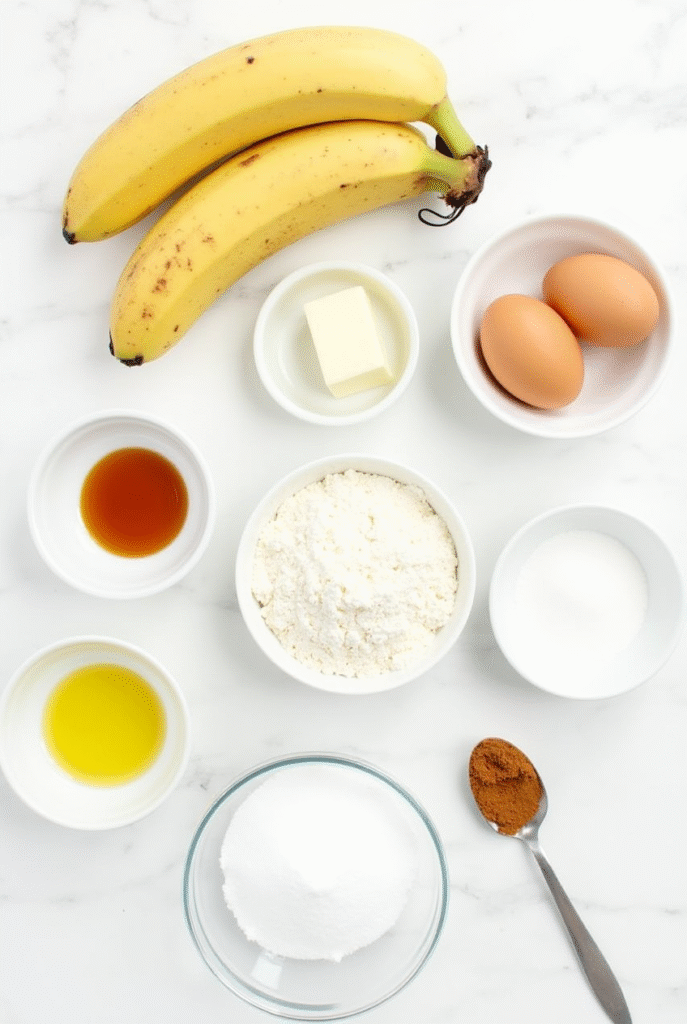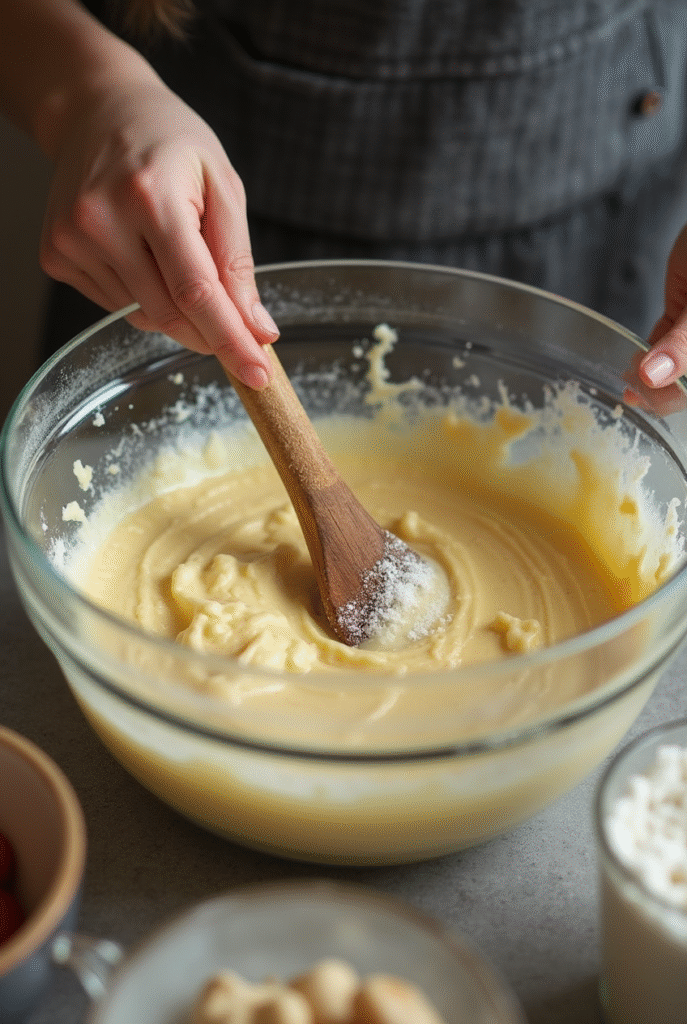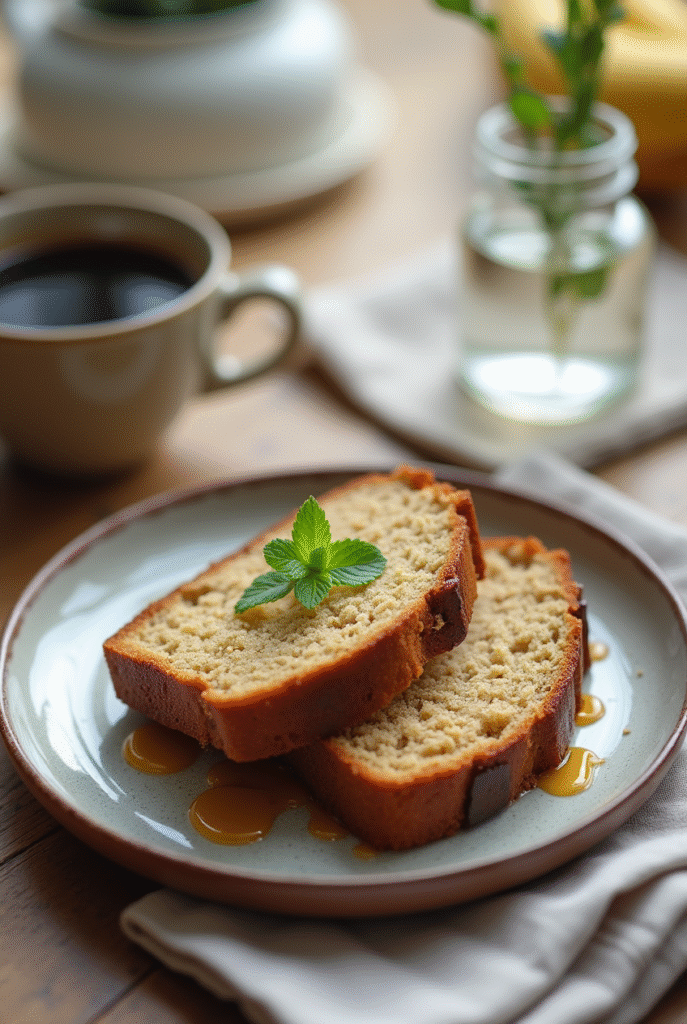Looking for a banana bread recipe without butter that still turns out moist, flavorful, and downright irresistible? You’re in the right place. Whether you’re avoiding dairy, cutting calories, or just out of butter—don’t worry. This recipe has your back.
In this article, we’ll dive into everything you need to know to master the art of baking delicious banana bread without a single pat of butter. From ingredients and techniques to nutrition tips and mouthwatering variations, it’s all here. You’ll even get answers to the most searched questions about this trending baking alternative.
Let’s get baking—with flavor, not with butter.
Table of Contents
Introduction to Butter-Free Banana Bread
Why Choose a Banana Bread Recipe Without Butter?
Banana bread is a timeless classic. But traditionally, it’s loaded with butter. So, what if you’re lactose intolerant, vegan, or just out to make a lighter version? Enter the banana bread recipe without butter. It’s not just a workaround—it’s a revelation.
You see, using oils like coconut or vegetable oil instead of butter doesn’t mean sacrificing taste or texture. In fact, it often makes the bread even moister. Plus, it’s a win for your heart and waistline. No butter? No problem.
Moreover, butter-free banana bread is a great choice for those wanting to cut down on saturated fat or experiment with dairy-free desserts. So whether you’re on a plant-based diet or just feeling adventurous in the kitchen, this twist on the classic loaf has something sweet in store.
Health Benefits of Omitting Butter in Banana Bread
Here’s the scoop: butter contains high levels of saturated fat, which, when consumed in excess, can contribute to heart disease. Swapping it out for healthier fats—think olive oil or avocado oil—can reduce those risks.
Additionally, using a banana bread recipe without butter often means fewer calories, making it a smarter choice for anyone watching their intake. Even better? The ripe bananas bring natural sweetness and moisture, so you can even reduce the sugar a bit.
Therefore, ditching butter isn’t just a dietary decision—it’s a health-forward, taste-friendly move that benefits everyone.
Overview of the Recipe and Its Appeal
This recipe isn’t just healthy—it’s crazy simple. No fancy equipment, no fussy steps. Just one bowl, a few everyday ingredients, and boom—you’ve got yourself a loaf that’s bursting with banana flavor.
In addition, you’ll discover how flexible this recipe is. Gluten-free? Vegan? Low-sugar? You can tweak it easily. And trust us, moist banana bread without butter isn’t just doable—it’s delicious.
Ready to see how? Let’s dive into the essential ingredients that make this magic happen.
Essential Ingredients for Butter-Free Banana Bread
Ripe Bananas: The Star Ingredient
Without question, ripe bananas are the soul of any banana bread recipe without butter. Their natural sugars not only sweeten the loaf but also keep it moist. The riper, the better—think lots of brown spots, soft to the touch, and incredibly fragrant.
Therefore, using overripe bananas reduces the need for added sugar or fat. Plus, they’re packed with potassium, vitamin B6, and fiber, making them a smart, tasty choice.
Alternative Fats: Oils and Their Impact on Texture
Instead of butter, we’re using oil. But not just any oil—choose neutral-flavored oils like vegetable oil, canola, or avocado oil. Coconut oil is great too if you want a light tropical note.
Why oil? Well, oil remains liquid at room temperature, giving the bread that soft, tender crumb we love. Moreover, oils are easier to mix in and less prone to clumping than cold butter.
Sweeteners: Natural vs. Refined Options
While white sugar works fine, you might also consider healthier alternatives. Honey, maple syrup, or even coconut sugar can be used for deeper, more complex sweetness.
However, keep in mind that liquid sweeteners may slightly alter texture and baking time. Adjust flour or baking time accordingly.
Flour Choices: All-Purpose, Whole Wheat, and Gluten-Free Alternatives
All-purpose flour is the go-to, but whole wheat flour adds a nutty flavor and fiber. If you’re aiming for a gluten-free version, try a 1:1 gluten-free baking mix.
Therefore, feel free to experiment—but always measure correctly to keep the loaf balanced and moist.
Optional Add-Ins: Nuts, Chocolate Chips, and Spices
Want to level up your loaf? Fold in chopped walnuts, dark chocolate chips, or dried fruits. Spices like cinnamon or nutmeg also enhance flavor.
In addition, these additions make the loaf feel special—perfect for guests or just treating yourself.
Ingredient Table for Banana Bread Recipe Without Butter:

| Ingredient | Quantity |
|---|---|
| Ripe bananas (mashed) | 3 large |
| All-purpose flour | 2 cups (250g) |
| Baking soda | 1 tsp |
| Salt | ½ tsp |
| Sugar (or substitute) | ½ to ¾ cup |
| Eggs | 2 large |
| Vanilla extract | 1 tsp |
| Vegetable oil | ½ cup |
| Optional: Nuts/Chips | ½ cup (each) |
| Ground cinnamon | 1 tsp (optional) |
Step-by-Step Guide to Making Banana Bread Without Butter
Preparing Your Ingredients and Equipment
First things first—gather your ingredients (see table above) and preheat your oven to 350°F (175°C). Grease a 9×5-inch loaf pan or line it with parchment paper. Trust us, this step will make your life easier later.
Moreover, make sure your bananas are well-mashed and your eggs are at room temperature. This ensures better mixing and a smoother batter.
Mixing Wet and Dry Ingredients Separately
In one bowl, whisk together the dry ingredients: flour, baking soda, salt, and any spices. In another bowl, combine the mashed bananas, sugar, eggs, vanilla, and oil.
Why mix separately? Because it helps avoid overmixing and ensures even distribution of the baking soda, which means a better rise.
Combining Mixtures for Optimal Texture
Now comes the fun part—slowly fold the dry mixture into the wet. Don’t overdo it. Stir just until combined. The batter should be thick but pourable. Overmixing can make your banana bread dense and rubbery, which nobody wants.
For example, if you’re adding nuts or chocolate chips, do it now with a few gentle stirs.
Baking Tips: Temperature and Time Guidelines
Pour the batter into your loaf pan and smooth the top. Bake for 50–60 minutes, but start checking at 45 minutes. Insert a toothpick in the center—if it comes out with a few moist crumbs, you’re golden.
Therefore, resist the urge to open the oven often; it can cause the loaf to sink in the middle.
Cooling and Storing Your Banana Bread
Once baked, let your banana bread cool in the pan for 10–15 minutes, then move it to a wire rack. Don’t skip this—cooling helps set the structure and makes slicing easier.
In addition, wrap leftovers tightly in foil or store in an airtight container. It’ll keep for up to 4 days at room temp or freeze beautifully for a month.

Variations of Butter-Free Banana Bread
Vegan Banana Bread: Egg Substitutes and Plant-Based Milks
Crafting a banana bread recipe without butter that’s also vegan is easier than you might think. Instead of eggs, you can use flaxseed meal or chia seeds mixed with water (1 tablespoon of seed to 3 tablespoons of water per egg) to bind the ingredients. These alternatives not only replace eggs effectively but also add a nutritional boost.
For the liquid component, plant-based milks like almond, soy, or oat milk work wonderfully. They maintain the moist texture of the bread while keeping it dairy-free. Moreover, these substitutions align perfectly with a vegan lifestyle without compromising on taste.
Gluten-Free Banana Bread: Flour Alternatives and Binding Agents
If you’re aiming for a gluten-free version, replacing traditional flour with gluten-free alternatives is key. Options like almond flour, coconut flour, or a gluten-free all-purpose blend can be used. However, it’s important to note that these flours behave differently, so adjustments in liquid ratios might be necessary.
To ensure the bread holds together well, adding binding agents like xanthan gum or guar gum can be beneficial. These help mimic the elasticity that gluten provides, resulting in a cohesive and enjoyable texture.
Low-Sugar and Sugar-Free Options
Reducing sugar doesn’t mean sacrificing flavor. Natural sweeteners like ripe bananas themselves, applesauce, or stevia can provide the desired sweetness. For instance, using extra ripe bananas can enhance the natural sweetness, allowing you to cut back on added sugars.
Additionally, incorporating spices like cinnamon or nutmeg can add depth and sweetness perception without additional sugar. These adjustments make the banana bread more suitable for those monitoring their sugar intake.
Flavor Twists: Incorporating Fruits, Nuts, and Spices
Elevate your banana bread recipe without butter by adding various mix-ins. Chopped nuts like walnuts or pecans introduce a delightful crunch. Dried fruits such as cranberries or raisins add chewiness and natural sweetness. Spices like cardamom or allspice can provide an exotic flair.cookscanvas
Moreover, swirling in nut butters or chocolate chips can create a decadent treat. These variations not only enhance flavor but also allow you to customize the bread to your preferences.
Nutritional Information and Health Considerations
Caloric Content and Macronutrient Breakdown
A typical slice of banana bread recipe without butter contains approximately 180-220 calories, depending on the specific ingredients used. By omitting butter, you significantly reduce the saturated fat content, making it a heart-healthier option.
The macronutrient distribution generally includes carbohydrates from the bananas and flour, a moderate amount of protein from eggs or plant-based alternatives, and healthy fats from oils or added nuts. This balance provides sustained energy and satiety.
Comparing Butter-Free to Traditional Banana Bread
Traditional banana bread recipes often rely on butter, contributing to higher saturated fat and cholesterol levels. In contrast, a banana bread recipe without butter utilizes oils like olive or canola, which are rich in unsaturated fats beneficial for heart health.
Moreover, the absence of butter makes the recipe more accommodating for those with lactose intolerance or dairy allergies. This adjustment not only caters to dietary restrictions but also aligns with health-conscious choices.
Dietary Considerations: Vegan, Gluten-Free, and Low-Sugar Diets
This versatile banana bread recipe without butter can be adapted to fit various dietary needs. For a vegan version, replace eggs with flax or chia seeds and use plant-based milk. To make it gluten-free, opt for certified gluten-free flours and ensure all other ingredients are free from gluten contamination.
For those monitoring sugar intake, natural sweeteners or reducing the overall sugar content can make the bread more suitable. These modifications ensure that the banana bread remains a delicious option for a wide range of dietary preferences.
Common Mistakes and Troubleshooting Tips
Avoiding Dense or Undercooked Bread
Sometimes, your banana bread recipe without butter might come out a bit too heavy or slightly raw in the middle. Why does this happen? Well, often it’s due to overmixing or baking at the wrong temperature.
To avoid this, gently mix the batter just until the flour disappears. Overmixing activates too much gluten, which leads to a dense loaf. Also, always preheat your oven and check that it actually reaches the right temperature—ovens can be tricky!
Moreover, using too many bananas can throw off the balance. Three medium to large bananas are ideal. Anything more, and your bread might turn into a gooey mess.
Preventing Overmixing and Its Effects
Here’s the thing: mixing your batter like you’re stirring cement won’t help! In fact, overmixing is one of the top mistakes bakers make. It leads to tough, chewy bread—and we want soft and tender.
So, after combining your wet and dry ingredients, fold them together with a spatula or wooden spoon. Stop mixing as soon as you no longer see dry flour. For extra lift and fluff, you can sift your dry ingredients beforehand—this also helps with even mixing.
Therefore, being gentle with your batter is a key step for success.
Adjusting for Altitude and Humidity Variations
If you live in a high-altitude area or somewhere humid, your banana bread recipe without butter might need slight tweaks. At high elevations, reduce baking soda slightly and increase the baking temperature by about 15–20°F.
In humid places, your flour might absorb more moisture from the air, so you may need to add a tablespoon or two more. Testing and adjusting is part of the fun—and gets you closer to that perfect slice.
Serving Suggestions and Pairings
Ideal Beverages to Accompany Banana Bread
This banana bread recipe without butter pairs beautifully with many drinks. A warm cup of coffee or a chai latte really brings out the spices if you’ve used cinnamon or nutmeg. In summer, a cold brew or iced tea offers a refreshing contrast to the rich flavor of the loaf.
For kids, a glass of oat milk or homemade smoothie can make a nourishing snack combo. In other words, banana bread can be as fancy—or as chill—as you want it to be.
Creative Serving Ideas for Different Occasions
Sure, you can eat it plain, but why not jazz it up a bit? For breakfast, toast a slice and spread some almond butter or jam on top. If you’re hosting guests, serve it warm with a scoop of dairy-free vanilla ice cream or a drizzle of honey.
Moreover, banana bread cubes can make a delightful addition to brunch boards. Cut into small pieces, they add a touch of sweetness among cheeses and fruits. This makes your butter-free loaf perfect for sharing—and showing off!
Storage Tips for Maintaining Freshness
To keep your banana bread recipe without butter fresh, wrap it tightly in foil or plastic wrap and store it at room temperature for up to four days. For longer storage, freeze individual slices and reheat when needed.
This way, you’ll always have a tasty treat ready to go—no butter needed.

Frequently Asked Questions (FAQs)
Can I Use Olive Oil Instead of Butter in Banana Bread?
Yes, absolutely! Olive oil is a great substitute in a banana bread recipe without butter. It adds moisture and healthy fats without altering the flavor too much. However, go for light or extra-light olive oil if you’re worried about any strong taste.
Moreover, olive oil can actually improve the texture, making the loaf tender and soft. So yes—swap it in with confidence.
How Do I Make Banana Bread Moist Without Butter?
Moisture comes from a few smart choices. First, use very ripe bananas—they’re naturally sweet and full of liquid. Second, oils like canola or coconut oil work wonders in keeping things soft.
In addition, don’t overbake! Pull it out when a toothpick shows just a few moist crumbs. And remember, storing it well—wrapped and at room temp—helps lock in that goodness.
What Are the Best Egg Substitutes for Vegan Banana Bread?
Great question! If you want your banana bread recipe without butter to be vegan too, try flax eggs (1 tbsp ground flax + 3 tbsp water per egg), mashed applesauce, or even mashed avocado.
Each one gives you moisture and binding power. Plus, they’re simple and plant-based.
Can I Freeze Banana Bread Without Butter?
Yes, you can! In fact, this banana bread freezes beautifully. Wrap it tightly in plastic, then foil, and store in a freezer bag. It’ll last for up to 3 months.
Therefore, you can always have a slice ready—just reheat in the toaster or microwave for a quick treat.
How Long Does Butter-Free Banana Bread Stay Fresh?
At room temperature, your loaf will stay fresh for about 3 to 4 days. However, if you refrigerate it, it can last up to a week. Just be sure to keep it in an airtight container or wrap it well to avoid drying out.
Conclusion and Final Thoughts
So there you have it—your ultimate banana bread recipe without butter. From the essential ingredients to the baking tricks, and even fun variations, now you’ve got all the tools to bake a loaf that’s as tasty as it is healthy.
Not only does this butter-free recipe meet a variety of dietary needs, but it’s also a smart choice for anyone wanting a lighter version of a classic favorite. Plus, it’s incredibly easy to customize—vegan, gluten-free, or low-sugar, you name it.
In addition, it’s a great way to use up ripe bananas and avoid food waste. Who knew healthy baking could be this good?
So why not give it a go today? Your kitchen will smell amazing, your taste buds will thank you, and your body might even thank you a little too.



